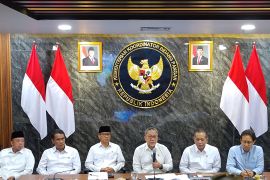Indonesia's foreign debt comprised public sector debt (government and central banks) of $183.8 billion and private sector debt, including SOEs, of $205.5 billion.
"This was caused by a decrease in public external debt and a slowdown in private external debt growth," the Department of Communication of Bank Indonesia (BI) stated in its latest info in Jakarta, Friday.
The government foreign debt at the end of the first quarter of 2020 contracted 3.6 percent yoy to $181.0 billion, thereby reversing the condition of the previous quarter that grew 9.1 percent yoy.
The decline in the government's external debt was influenced by capital outflows from the bond market and payments of matured sovereign debt papers.
According to BI, the government’s external debt is being managed in a careful and accountable manner to support priority spending on productive sectors that bolster economic growth and public welfare.
The productive sectors comprised the health service sector and social activities, 23.1 percent of the total government external debt; construction sector, 16.3 percent; the education service sector, 16 percent; the financial services sector and insurance, 13.3 percent; as well as the government administration, defense and mandatory social security sectors, 11.5 percent.
Meanwhile, the slowing trend in private external debt is ongoing. Private external debt at the end of Q1 of 2020 grew 4.5 percent yoy, lower than the previous quarter's growth of 6.6 percent yoy.
"This is owing to contraction of external debts in non-financial institutions and slower expansion of external debt in financial institutions," BI stated.
At the end of Q1 of 2020, the external debt of financial institutions contracted 2.3 percent yoy, reversing the previous quarter growth of 3.6 percent yoy. Non-financial institutions' foreign debt also slowed down, from 7.6 percent yoy in the fourth quarter of 2019 to 6.7 percent yoy in the first quarter of 2020.
Some sectors with the largest share of foreign debt, accounting for 77.7 percent of the total private external debt, are mining, manufacturing, financial services & insurance and electricity, gas, and steam procurement, and the industrial sector processing.
BI views Indonesia's overall external debt level as healthy, supported by applying the principle of prudence in its management.
This condition was mirrored in the ratio of Indonesia's external debt to gross domestic product (GDP) at the end of Q1 of 2020 recorded at 34.5 percent, down from the previous quarter’s 36.2 percent.
In addition, long-term loans constitute 88.4 percent of Indonesia's current outstanding debt.
In a bid to maintain a healthy foreign debt structure, BI and the government are constantly striving to enhance coordination in monitoring the development of external debt, supported by the application of the principle of prudence in its management.
"The role of foreign debt will also continue to be optimized in supporting development funding by minimizing risks that can affect economic stability," the BI stated.
Related news: Foreign debt is within safe limit: Bank Indonesia
Related news: Indonesia's external debt rises 11.9 percent in Oct 2019
Related news: Foreign capital inflow reaches Rp220.9 trillion until November
Translator: Achmad Buchori, Azis Kurmala
Editor: Sri Haryati
Copyright © ANTARA 2020











